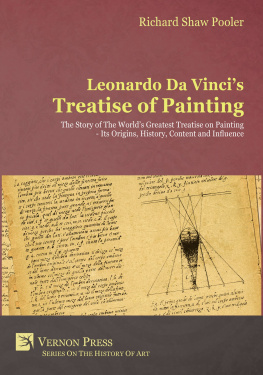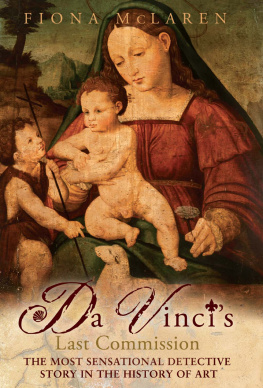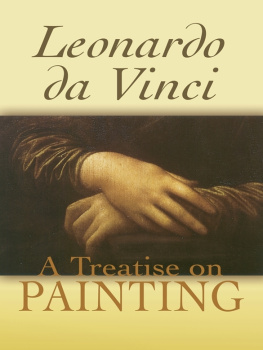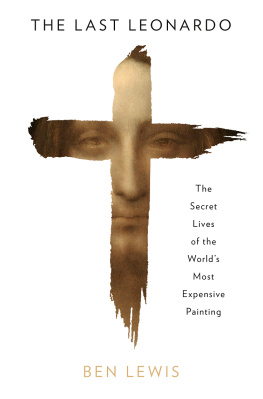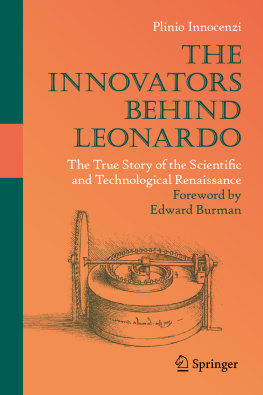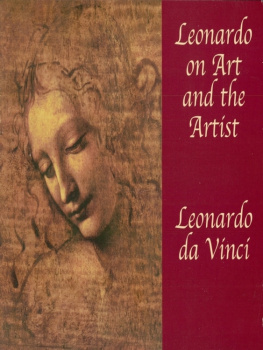Leonardo da Vincis
Treatise of Painting
The Story of the Worlds
Greatest Treatise on Painting
Its Origins, History, Content and Influence
Richard Shaw Pooler

Copyright 2014 Vernon Press, an imprint of Vernon Art and Asc i ence Inc, on behalf of the author.
All rights reserved. No part of this publication may be reproduced, stored in a retrieval system, or transmitted in any form or by any means, electronic, mechanical, photocopying, recording, or othe r wise, without the prior permission of Vernon Art and Science Inc.
www.vernonpress.com
In the Americas: Vernon Press 1000 N West Street, Suite 1200, Wilmington, Delaware 19801 United States | In the rest of the world Vernon Press C/Sancti Espiritu 17, Malaga, 29006 Spain |
Library of Congress Control Number: 2014942094
ISBN 978-1-62273-048-3
Contents
Introduction
Leonardo da Vincis Treatise of Painting is still being reprinted nearly 500 years after his death. It is arguably the most important treatise on the theory and practice of art ever written. Yet it had to wait till the middle of the 17 th century to be published for the first time, more than 130 years after Leonardos death in 1519. It is surprising how many treatises were written and published by artists and architects throughout the Renaissance, and even up to the 18 th century but there was always that gap in the record, the omission of Leonardos own work, until part of it was first published in 1651. Up until then, his many manuscripts circulated freely among artists and thin k ers of the day, and were recognised even then as being outstanding and ground-breaking. So much so that many were copied time and again, and parts of them ended up in the treatises of other writers and artists. That was common practice at the time and cross-pollination of ideas in different treatises was usual, without the acknowledgement of sources that is esse n tial today. Nevertheless, Leonardos thinking can be traced from his original manuscripts through many ot h ers to show his influence long before his own work was published.
His manuscripts were written in the last thirty years of his life and cover an astonishing range of subjects. He wrote about anatomy, hydraulics, the horse, perspective, flight, optics, mechanics and much, much more. He in fact tried to compile an encyclopaedia of knowledge which he illustrated with drawings in a number of di f ferent manuscripts, and those that survive are today in major collections around the world. It was from those manuscripts, and others that are now lost, that Leona r dos comments on art were copied and compiled by Francesco Melzi into a manuscript known as the Treatise of Painting , and later renamed the Codex Urbinas that is now in the Vatican library. It is that manuscript that b e came the basis for the printed editions of the Treatise of Painting , which were initially abridged editions. This text tells the story of how the Treatise of Painting came about, how it developed, and how it was eventually published, and its subsequent influence.
So much has been written about Leonardo, his pain t ings, his personality, his background, his extraordinary inventions, and so on. Those topics are not within the scope of this text. This attempt to write about the origins and development of the Treatise of Painting is confined within narrower parameters.
The first part is really a brief overview of where Le o nardo lived at different times of his life, and which pain t ings and manuscripts he produced in each place. It shows how his interests began to move beyond painting, and how he started recording his thoughts on a wide range of subjects in a number of manuscripts. The wri t ing of those manuscripts became a parallel activity to the planning and production of his paintings, and many of them contain preliminary sketches and details for various paintings, as well as his thoughts on art, science, mechanics and the world around him.
The subsequent history of his manuscripts after Le o nardo reached the end of his life then follows, showing what happened to them, which survived and where they are now. Part of that story is how the manuscripts di s persed, many were lost, others were rescued, some r e constructed, and some were despoiled. One of the man u scripts that was lost was Melzis Treatise of Painting i t self. Despite that, the fascinating figure of Cassiano dal Pozzo made great efforts to compile a Treatise of Painting from other copies of early manuscripts, and he was successful. At last, in 1651, Leonardos Treatise of Painting was published in Paris, in Italian and French more or less simultaneously.
With Leonardos Treatise of Painting in print, there arose the obvious question, What does it say? There is therefore a chapter which attempts to define what the Treatise of Painting actually says about the theory and practice of art, showing how Leonardo took fragmented theories from the Middle Ages , and helped establish a unified theory of art in the Renaissance.
1651 was a watershed year. Now that Leonardos thin k ing on art was available in printed form, albeit in an abridged edition, it had a growing influence on other writers on art, notably in France, Spain, Germany and Holland. It influenced the Academies, especially in Paris, Rome and then England, and was read and commented upon by a growing number of artists, writers and critics. Then came the publication of the complete editions of the Codex Urbinas , starting with the Manzi edition of 1815. Finally, facsimiles appeared of Leonardos survi v ing manuscripts, accompanied by a flood of critical commentary.
This text begins by showing how his painting and the compiling of his notes proceeded as parallel activities. The story of what happened to his notes then follows. The subsequent history of his paintings is then briefly traced, detailing their provenance, and where they are now.
Several books on Leonardos work have touched on di f ferent aspects of Leonardos Treatise of Painting . This text attempts to trace the complete story of the Treatise , its origins, history, development, content and influence. The twists and turns in the events that led to its survival are remarkable, but so was its influence.
Leonardo 1452
Ser Piero da Vinci, 26 years old, lived in the small vi l lage of Vinci, consisting of perhaps twenty to thirty hou s es, which lay 35 kilometres west of Florence. His title Ser indicated that he was a notary, as was his father, and his father before that. The family lived together in a large house owned by Pieros father Ser Antonio, in a typical rural community that depended on the cultivation of olives, vines and medicinal herbs for its livelihood.
About 3 kilometres away lay the small hamlet of A n chiano, and there lived Caterina in a farmhouse. Until recently that was the accepted scenario. Piero and C a terina met, and in the middle of 1451 their friendship turned to passion. Like countless other village roman c es, the result was that the sixteen year old Caterina fell pregnant, with the subsequent illegitimate birth of Ser Pieros first son in the spring of 1452.
Whatever the nature of their affair, Ser Piero refused to marry her, but went to some lengths to make the birth of his first son respectable. He had him baptised by a priest, with five men and five women present from the community. This was recorded by the childs grandfather Ser Antonio, who wrote:
My grandson was born, son of Ser Piero, my son, on April 15, Saturday, at three in the night.
Next page
